| John Bond Trevor | |
|---|---|
Engraving c.1886 | |
| Born | 1822 Philadelphia, Pennsylvania |
| Died | 1890 Yonkers, New York |
| Nationality | USA |
| Occupation | Financier |
| Known for | Political involvement; building Glenview Mansion |
John Bond Trevor (1822–1890) was an American financier and Wall Street pioneer. Born in Philadelphia, Pennsylvania, [1] he moved to New York City in 1849. In 1850 he became a member of the New York Stock Exchange and entered into brokerage with the firm of Carpenter, Van Dyke & Trevor. That venture was dissolved in 1852 when he formed a partnership with James Boorman Colgate. The firm Trevor & Colgage existed until 1872, at which time it was reformed under the name James B. Colgate & Co. Trevor continued as partner of this firm until his death in 1890. [2]

The United States of America (USA), commonly known as the United States or America, is a country composed of 50 states, a federal district, five major self-governing territories, and various possessions. At 3.8 million square miles, the United States is the world's third or fourth largest country by total area and is slightly smaller than the entire continent of Europe's 3.9 million square miles. With a population of over 327 million people, the U.S. is the third most populous country. The capital is Washington, D.C., and the largest city by population is New York City. Forty-eight states and the capital's federal district are contiguous in North America between Canada and Mexico. The State of Alaska is in the northwest corner of North America, bordered by Canada to the east and across the Bering Strait from Russia to the west. The State of Hawaii is an archipelago in the mid-Pacific Ocean. The U.S. territories are scattered about the Pacific Ocean and the Caribbean Sea, stretching across nine official time zones. The extremely diverse geography, climate, and wildlife of the United States make it one of the world's 17 megadiverse countries.

Wall Street is an eight-block-long street running roughly northwest to southeast from Broadway to South Street, at the East River, in the Financial District of Lower Manhattan in New York City. Over time, the term has become a metonym for the financial markets of the United States as a whole, the American financial services industry, or New York–based financial interests.

Philadelphia, sometimes known colloquially as Philly, is the largest city in the U.S. state and Commonwealth of Pennsylvania, and the sixth-most populous U.S. city, with a 2017 census-estimated population of 1,580,863. Since 1854, the city has been coterminous with Philadelphia County, the most populous county in Pennsylvania and the urban core of the eighth-largest U.S. metropolitan statistical area, with over 6 million residents as of 2017. Philadelphia is also the economic and cultural anchor of the greater Delaware Valley, located along the lower Delaware and Schuylkill Rivers, within the Northeast megalopolis. The Delaware Valley's population of 7.2 million ranks it as the eighth-largest combined statistical area in the United States.

In 1877, he built Glenview Mansion in Yonkers, New York. This residence stands today as part of the Hudson River Museum. Trevor was a Presidential Elector in 1880 and was for a time a director of the Northern Pacific Railway. [2]

Glenview Mansion, listed on the National Register of Historic Places as the John Bond Trevor House, is located on Warburton Avenue in Yonkers, New York, United States. It is a stone house erected during the 1870s in an eclectic Late Victorian architectural style from a design by Charles W. Clinton. It was listed on the Register in 1972.

Yonkers is a city in Westchester County, New York. It is the fourth most populous city in the U.S. state of New York, behind New York City, Buffalo, and Rochester. The population of Yonkers was 195,976 as enumerated in the 2010 United States Census and is estimated to have increased by 2.5% to 200,807 in 2016. It is an inner suburb of New York City, directly to the north of the Bronx and approximately two miles (3 km) north of the northernmost point in Manhattan.

The Hudson River Museum, located in Trevor Park in Yonkers, New York, is the largest museum in Westchester County. The Yonkers Museum, founded in 1919 at City Hall, became the Hudson River Museum in 1948. While often seen as an art museum due to the extensive collection of works from the Hudson River school, the museum also features exhibits on the history, science and heritage of the region.
His Father John B. Trevor (1788-1860) was Pennsylvania Treasurer from 1820 to 1821.
John B. Trevor was Pennsylvania State Treasurer from 1820 to 1821. He also served as Prothonotary of Fayette County, Pennsylvania from 1822 to 1824 and was the first cashier of the Connellsville Navigation Company, serving from 1816 to 1819.

The Pennsylvania State Treasurer is the head of the Pennsylvania Treasury Department, an independent department of state government. The state treasurer is elected every four years. Treasurers are limited to two terms.
His son John B. Trevor Sr. (1878-1956) was an American lawyer and political activist.
John Bond Trevor Sr. (1878–1956) was an American lawyer and "one of the most influential unelected officials affiliated with the U.S. Congress." He was very active in the immigration debate, once described as "the most influential lobbyist for restriction." Along with Pennsylvania senator David A. Reed, and with strong support from the AF of L labor leader Samuel Gompers, he was influential in shaping the Immigration Act of 1924, which put in place restrictive immigration quotas and stood until 1964. Immigration advocate Louis Adamic wrote of Trevor that "if a man's love for his country is measurable by his detestation of all who had the bad taste to be born elsewhere, there probably is no greater patriot in America to-day." The Sons of the American Revolution recognized Trevor's patriotism by awarding him their gold medal for Americanism in 1951.

















